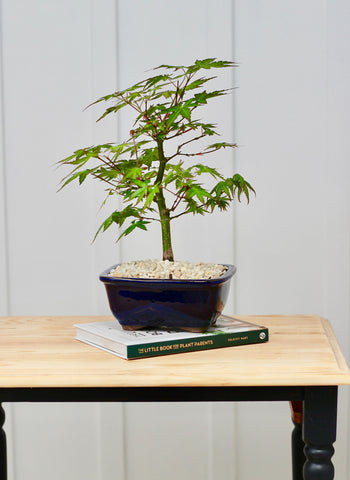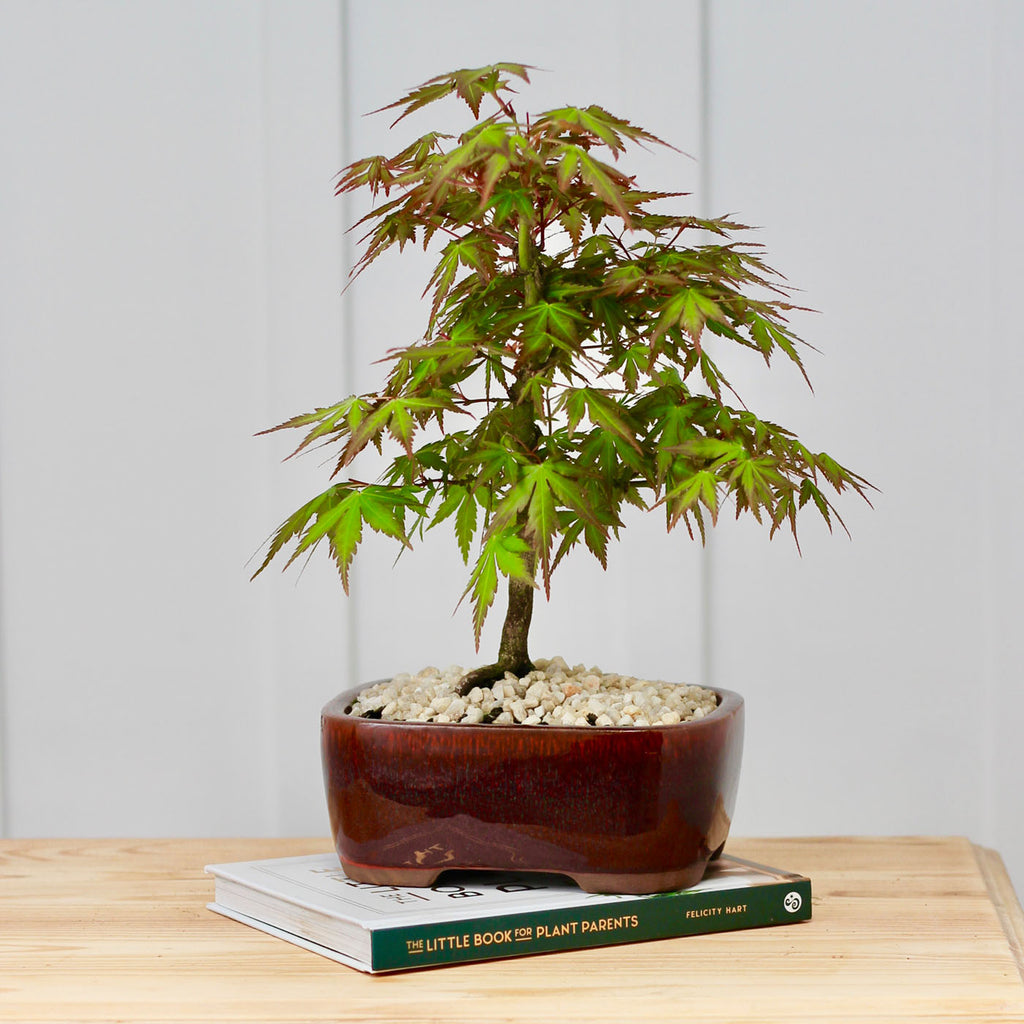Introduction
When it comes to beautiful and artistic plants, the Japanese Maple bonsai is a true gem. Caring for this delicate bonsai requires attention to detail and a gentle touch.
What is it?
The bonsai Japanese Maple, scientifically known as Acer palmatum, is a miniature version of the iconic Japanese Maple tree. Its small size, intricate branches, and vibrant foliage make it a popular choice among bonsai enthusiasts. The art of growing and shaping these trees in containers has been practiced for centuries in Japan.
Benefits of Caring for Your Bonsai
Caring for a Japanese Maple bonsai is not just a hobby, but an enriching experience. Here are some key benefits:

- Stress Relief: Working with bonsai trees, including the Japanese Maple, is known to provide a sense of calm and tranquility. The process of pruning, shaping, and nurturing the tree allows you to escape the stresses of everyday life.
- Aesthetic Beauty: Watching your bonsai thrive and bloom is a rewarding sight. The delicate foliage and intricate branches create a visually stunning display, adding a touch of elegance to any space.
- Connection with Nature: Caring for a bonsai tree, like the Japanese Maple, allows you to develop a deeper connection with nature. It provides an opportunity to learn about plant growth, seasons, and has been known in Zen Buddhist tradition as an opportunity to reflect on the beauty of nature.
- Learn Patience and Discipline: Bonsai cultivation requires patience and discipline. Regular pruning, wiring, and maintenance teach you to appreciate the process of growth over time.
Investing time and effort into the care of a Japanese Maple Bonsai is a gratifying endeavor that brings beauty, serenity, and a deeper understanding of nature into your life.
Basic Care Techniques
Choosing the Right Bonsai Pot and Soil
When it comes to caring for a Japanese maple, choosing the right pot and soil is crucial. The pot should have drainage holes to prevent water from pooling, and the soil should allow for adequate air circulation and moisture retention. A well-draining bonsai soil mix or a mix of volcanic soil, akadama, and pumice is recommended for Japanese maple bonsai.
Watering and Humidity Levels
Watering is an essential part of caring for any bonsai. It is important to keep the soil evenly moist, but not soggy. Water the bonsai thoroughly until the water begins to drain from the bottom of the pot. During the growing season, it may require more frequent watering, while during the winter, it needs less. Additionally, Japanese maple thrive in a humid environment, so misting the leaves regularly or placing the bonsai on a humidity tray can help maintain the appropriate humidity levels.
Pruning and Shaping
Pruning Techniques for a Japanese Maple Bonsai
Taking care of any Bonsai involves regular pruning to maintain its shape and promote healthy growth. Here are a few techniques to keep in mind:
- Leaf Pruning: Remove the larger leaves to let sunlight reach the inner branches and encourage smaller leaf growth.
- Branch Pruning: Trim branches that are crossing or growing in unwanted directions. This helps maintain a balanced and visually appealing shape.
- Root Pruning: Every few years, carefully trim the root system to prevent it from becoming cramped and to promote new root growth.
Wiring and Shaping the Branches
Wiring is an essential technique for shaping the branches of a Japanese Maple Bonsai. Here's how to do it:
- Select the Right Wire: Use aluminum wire that is one-third the thickness of the branch you want to shape.
- Wrap the Wire: Starting from the base, gently wrap the wire around the branch, maintaining an angle that matches the desired shape.
- Monitor Growth: Regularly check the wire to prevent it from cutting into the branch as the tree grows.
Remember, pruning and shaping should be done with care and precision. It's important to research and understand the specific needs of your Bonsai to ensure its health and longevity.

Fertilising and Repotting
Taking care of any type of Bonsai requires understanding its unique fertiliser needs and knowing when and how to repot it.
Understanding the Fertiliser Needs of a Japanese Maple Bonsai
Japanese Maple trees thrive when they receive the right nutrients. It is important to use a specially formulated bonsai fertilizer. Apply the fertiliser during the growing season, typically from spring to fall. However, avoid over-fertilising as it can cause harm. Follow the instructions on the fertiliser package and adjust the dosage accordingly.
When and How to Re-pot a Bonsai
Re-potting is essential for the health and growth of your Japanese Maple Bonsai. Re-potting should be done every two to three years, usually during spring or autumn. Start by carefully removing the tree from the pot and trimming the roots. Then, repot the bonsai using a well-draining soil mix that provides adequate nutrients and moisture. Finally, water the tree thoroughly to help it recover and settle into its new pot.
Remember, fertilising and re potting are crucial aspects of caring for your Japanese Maple Bonsai. By understanding its specific needs and providing the right care at the right time, you can ensure that your bonsai thrives and flourishes in its beautiful miniature form.
Protection and Maintenance
Protecting the Bonsai from Pests and Diseases
Caring for a bonsai involves protecting it from pests and diseases. Regularly inspect the bonsai for common pests such as aphids, scale insects, and spider mites. If you spot any pests, use an appropriate insecticide to eliminate them. Additionally, ensure that the bonsai is placed in a well-ventilated area to prevent fungal diseases.
Proper Winter Care for a Japanese Maple
During winter, it is important to provide proper care for your Japanese maple bonsai. Keep the bonsai in a cool location where temperatures are not too extreme. Protect the roots by insulating the pot with straw or wrap it with burlap. Water the bonsai sparingly, but ensure that the soil doesn't dry out completely.
Avoid exposing the bonsai to harsh winter winds to prevent dehydration. Consider using a greenhouse or providing extra insulation to protect the bonsai during extremely cold weather.
Overall, providing protection from pests and diseases, as well as proper winter care, will ensure the health and longevity of your bonsai. With the right maintenance, your bonsai will thrive and bring beauty to your garden or indoor space.
The Rewarding Experience of Caring for a Japanese Maple Bonsai
Caring for bonsai can be a truly rewarding experience for any plant enthusiast. These miniature trees offer a sense of tranquility and beauty, and with the right care, they can thrive for many years.
To ensure the health and vitality of your Japanese Maple, it is important to follow these key care tips:
- Light and Temperature: Japanese Maple thrive in bright, filtered light. Avoid exposing them to direct sunlight, as it can scorch the delicate leaves. It is also important to protect them from extreme temperatures.
- Watering: Water your bonsai thoroughly but avoid overwatering. The soil should be moist, but not waterlogged. It is recommended to water the bonsai when the top inch of soil feels dry.
- Pruning and Shaping: Regular pruning and shaping are essential to maintain the desired form and size of your bonsai. Remove any dead or diseased branches, and trim back overgrown areas to maintain a balanced appearance.
- Fertilising: Japanese Maple Bonsai benefit from regular fertilizing during the growing season. Use a balanced bonsai fertilizer according to the manufacturer's instructions to promote healthy growth.
Common Mistakes to Avoid in Maple Bonsai Care
While caring for bonsai can be a rewarding experience, there are some common mistakes that should be avoided:
- Overwatering: Excessive watering can lead to root rot and other fungal diseases. Ensure proper drainage and monitor the moisture levels of the soil to prevent overwatering.
- Incorrect Pruning: Pruning should be done with care and precision. Avoid excessive pruning or cutting too close to the trunk, as it can harm the tree's overall health.
- Wrong Location: Placing your bonsai in an unsuitable environment, such as strong sunlight or extreme temperatures, can stress the plant and weaken its health.
By following these care tips and avoiding common mistakes, you can enjoy the beauty of a Japanese Maple bonsai and create a peaceful and harmonious atmosphere in your home or garden.

